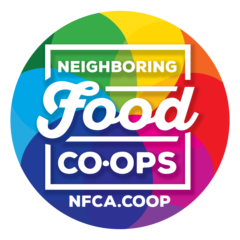The Food Co-op and Healthy Food Access project identified six components that food co-ops should consider when developing programs to increase access to healthy food for underserved communities. These themes represent the points of interaction where a previously unengaged person could face barriers to participation in a co-op, and how co-ops can address these barriers.
1. Collaboration with Partner Organizations: Food co-ops will benefit in their outreach by identifying and partnering with organizations, such as social service providers or community health centers, who have strong relationships with low-income community members and who share the goal of healthy food access,. Examples of such collaboration include publicity for the co-op’s products and services, dialog to better understand community needs, and implementation of related programs such as education, training and community-based food subsidies. There is also an opportunity to communicate more strongly the contribution of co-operative enterprise to more resilient local economies, employment, and access to products and services on which our communities rely.
2. Educational Opportunity: Relationships with underserved communities offer opportunities for education on how the co-op differs from conventional grocery stores in ways that help the community. For example, education on how to shop for healthy food on a tight budget could highlight nutrition education, the high cost of processed food, meal planning, and how to navigate the food co-op, including the bulk aisle — unfamiliar to most non-co-op shoppers, but essential to eating well on a budget. Education on ownership benefits can highlight member participation and dividends, something no conventional grocer would offer. Another great educational opportunity is highlighting the co-op’s connection with other places in the community that shoppers value (such as libraries, public school, sponsoring certain events, etc.).
3. Product Affordability: Co-ops may need to examine the perceptions and realities that sometimes discourage participation by members of marginalized communities, especially the cost of food. Food co-ops can start addressing affordability by accepting SNAP and other public food subsidies and can carry some conventional, generic products to give shoppers additional lower-cost choices. Additional programs include reducing the margin on certain line of products, or offering a needs-based discount to eligible consumers. Co-ops also face the challenge of limited economies of scale in local and regional sourcing and may want to look at ways to build efficiencies through collective sourcing and collaboration.
4. Accessible Ownership Options: Co-operative membership is the key component to maintaining community control and ensuring the co-op meets community needs. If marginalized communities have difficulty accessing membership, ownership and control, the co-op will find it more difficult to meet their needs and will not benefit from their participation. This will make it difficult to expand healthy food access in a manner that encourages engagement. Many food co-ops have programs that attempt to address this challenge, including subsidizing member shares, allowing members to buy their share over an extended time period, or allowing some degree of control to members who have not fully purchased their share.
5. Inclusive Marketing: What is your Co-op doing to make everyone feel welcome? If you want more customers with limited budgets to come to your co-op, it is important to market to low-income shoppers. Co-ops can create a welcoming environment by designing signage, marketing, providing products that appeal to low-income consumers. For example, co-ops stores can display small signs that say “Great Deal!” or “Everyday Basics!” or something similar next to affordable healthy items such as like in-season produce, milk, bulk grains, and dry beans.
6. Infrastructure: Co-ops should consider both the internal and external infrastructure to support on-going success of these programs. Internal infrastructure could include budgeting for outreach and education staff, using point of sale programs to facilitate internal subsidy programs, and posting signage in multiple languages, as needed. Co-op associations such as the NFCA could also provide shared resources to support these activities among member co-ops. External infrastructure directly impacts participation of marginalized communities in the co-op, particularly public transportation. But even these external infrastructural barriers might be overcome through the use of satellite or mobile retail outlets, where the co-op provides a limited variety of products for sale in off-site locations.

